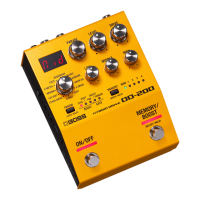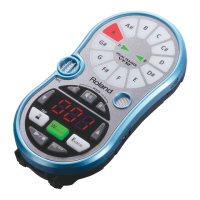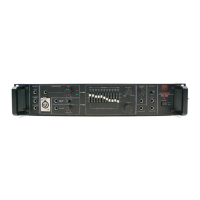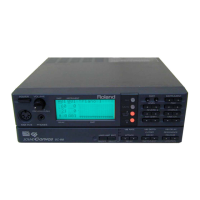QUICK GUIDE 29
Afspil Rhythms
1. Indstil BK-3 [Volume] knap til et passende niveau.
2. Tryk på [SPLIT] knappen hvis du ønsker at spille med keyboardet opdelt i 2 sektioner
(split).
Keyboardet opdeler automatisk split ud fra tangentnummer 60 (C4). Hvis split ønskes
et andet sted på keyboardet, så kan dette ændres (se i engelske vejledning ”Split
Point” side 47).
3. Vælg rytme som du ønsker at spille med.
4. Hold [EXIT] knappen nede indtil displayet viser hovedskærmbilledet.
5. Vælg en af rytmevariationerne [1], [2], [3] eller [4], afhængig hvor kompleks dit rytme
akkompagnement skal være.
6. Tryk på [INTRO] knap for at vælge at rytme skal starte med en kort introduktion.
(lampe lyser).
Playing with Automatic Accompaniments
24
[AUTO FILL IN]
When this button lights, the BK-3 plays a transition before switching
to the newly selected VARIATION pattern. Example: if the VARIATION
[1] pattern is running, pressing the [4] button will not switch to that
pattern right away—the BK-3 rst plays a ll-in to announce the
new song section.
NOTE
The duration of the ll-ins (transitions) can be halved if you like.
See “Fill In Half Bar” on p. 49. You can also speed up or slow
down playback during a ll-in. See “Fill Ritardando” on p. 49.
Selecting Rhythms
1. Press a RHYTHM FAMILY button to select the rhythm
family.
NOTE
By pressing and holding one of these buttons, you activate the
lock function for rhythm selection, which means that rhythms
no longer change when you select Performance memories (see
p. 39).
The display shows a list of the rhythms that belong to this family. If
the currently selected rhythms belongs to the family whose button
you pressed, its name is displayed in reverse and the indicator of
the button you pressed lights:
If you press a dierent RHYTHM FAMILY button, the display shows
the beginning of the associated list (but the indicator of the
associated family button doesn’t light):
2. Press the [INC] or [DEC] button to select another desired
Rhythm in the list.
The name of selected Rhythm is displayed in reverse.
3. You can also use the [UP] or [DOWN] button to move the
cursor in the list and then press [ENTER] to select the
Rhythm.
In this case the Rhythm is recalled when you press the [ENTER]
button.
4. If you need select a Rhythm of another family, press
another Rhythm button and repeat the step 2.
5. Press [EXIT] to leave the Rhythm selection page.
MEMO
Rhythms can also be selected by simply pressing the [NUMERIC]
key and entering their number (p. 20).
Playing Back Rhythms
1. Set the BK-3’s [VOLUME] knob to a reasonable level (about
1/4).
2. Press the [SPLIT] button if you want to play in Split mode.
MEMO
The default setting for the split point is note number 60 (C4).
You can change the split point to a dierent note (see “Split
Point” p. 47.
3. Select the rhythm you want to use.
4. Press the VARIATION [1], [2], [3] or [4] button to select the
complexity of the verse pattern.
For example press the VARIATION [2].
5. Press the [INTRO] / [ & ] button (it lights) to start rhythm
playback with an introduction.
Playing with Automatic Accompaniments
24
[AUTO FILL IN]
When this button lights, the BK-3 plays a transition before switching
to the newly selected VARIATION pattern. Example: if the VARIATION
[1] pattern is running, pressing the [4] button will not switch to that
pattern right away—the BK-3 rst plays a ll-in to announce the
new song section.
NOTE
The duration of the ll-ins (transitions) can be halved if you like.
See “Fill In Half Bar” on p. 49. You can also speed up or slow
down playback during a ll-in. See “Fill Ritardando” on p. 49.
Selecting Rhythms
1. Press a RHYTHM FAMILY button to select the rhythm
family.
NOTE
By pressing and holding one of these buttons, you activate the
lock function for rhythm selection, which means that rhythms
no longer change when you select Performance memories (see
p. 39).
The display shows a list of the rhythms that belong to this family. If
the currently selected rhythms belongs to the family whose button
you pressed, its name is displayed in reverse and the indicator of
the button you pressed lights:
If you press a dierent RHYTHM FAMILY button, the display shows
the beginning of the associated list (but the indicator of the
associated family button doesn’t light):
2. Press the [INC] or [DEC] button to select another desired
Rhythm in the list.
The name of selected Rhythm is displayed in reverse.
3. You can also use the [UP] or [DOWN] button to move the
cursor in the list and then press [ENTER] to select the
Rhythm.
In this case the Rhythm is recalled when you press the [ENTER]
button.
4. If you need select a Rhythm of another family, press
another Rhythm button and repeat the step 2.
5. Press [EXIT] to leave the Rhythm selection page.
MEMO
Rhythms can also be selected by simply pressing the [NUMERIC]
key and entering their number (p. 20).
Playing Back Rhythms
1. Set the BK-3’s [VOLUME] knob to a reasonable level (about
1/4).
2. Press the [SPLIT] button if you want to play in Split mode.
MEMO
The default setting for the split point is note number 60 (C4).
You can change the split point to a dierent note (see “Split
Point” p. 47.
3. Select the rhythm you want to use.
4. Press the VARIATION [1], [2], [3] or [4] button to select the
complexity of the verse pattern.
For example press the VARIATION [2].
5. Press the [INTRO] / [ & ] button (it lights) to start rhythm
playback with an introduction.
Playing Back Rhythms
25
6. Press the VARIATION [1], [2], [3] or [4] button to select the
complexity of the INTRO pattern.
For example press the VARIATION [3].
The VARIATION button pressed at the step 6. lights and the
VARIATION button pressed at the step 4. ashes to indicate the
verse complexity that will be played back at the end of the Intro
pattern.
7. Play a chord on the keyboard.
8. The main page displays the name of the last chord the
BK-3 recognized:
9. Press the [START/STOP]/[*/,] button to start rhythm
playback.
The [START/STOP]/[ */, ] indicator lights and the BK-3 starts playing
back the introductory phrase.
10. Play dierent chords on the keyboard and listen to the
eect this has on the rhythm.
11. Switch on the [AUTO FILL IN] button (it lights).
This means that when you select a dierent VARIATION pattern,
the BK-3 will play a transition (ll-in) before switching to the new
pattern.
12. Press a VARIATION [1], [2], [3] or [4] button to select a
more complex or a simpler accompaniment.
• If you press it before the last beat of the current measure, the ll-in
starts immediately and lasts until the end of the current measure,
then the newly selected VARIATION pattern is played back.
• • If you press the desired VARIATION button on the last beat of a bar,
the ll-in starts at the next downbeat and lasts an entire bar. Only
then will the BK-3 switch to the newly selected VARIATION pattern.
13. If necessary, you can change the rhythm’s tempo:
• Press the TEMPO [] or [] button to decrease or increase the
tempo
• Press the [TAP TEMPO] button at least three times at the desired
tempo.
The BK-3 calculates the intervals between your presses and sets the
corresponding tempo value.
MEMO
Simultaneously press the TEMPO [] and [] buttons
(“STANDARD”) to return to the rhythm’s preset tempo.
TIPS
You can press and hold the [TAP TEMPO] button to lock the
tempo setting (see p. 39).
14. Press the [ENDING] / [ & ] button to end rhythm playback
with a suitable closing section.
You could also stop playback simply by pressing the [START/STOP]/
[ */, ] button or by releasing all keys on the keyboard (see “[SYNC
START] / [ + ]” p. 22).
While rhythm or SMF song playback is stopped, the [TAP TEMPO]
button ashes to indicate the selected tempo.
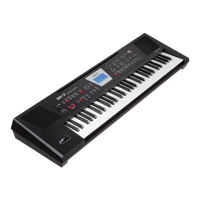
